Ocean sunfish
| Ocean sunfish Temporal range:
Middle Holocene–present(5,941–0YBP)[1] | |
|---|---|
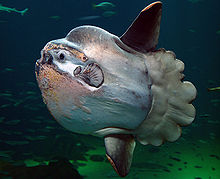
| |
| Nordsøen Oceanarium,Denmark | |
| Scientific classification | |
| Domain: | Eukaryota |
| Kingdom: | Animalia |
| Phylum: | Chordata |
| Class: | Actinopterygii |
| Order: | Tetraodontiformes |
| Family: | Molidae |
| Genus: | Mola |
| Species: | M. mola
|
| Binomial name | |
| Mola mola | |
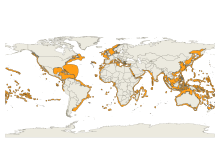
| |
| IUCN distribution of the ocean sunfish
Extant (resident)
| |
| Synonyms[5] | |
Theocean sunfishorcommon mola(Mola mola) is one of the largest bony fish in the world. It is thetype speciesof the genusMola,and one of five extant species in the familyMolidae.[6][7]It was once misidentified as the heaviest bony fish, which was actually a different and closely related species of sunfish,Mola alexandrini.[8]Adults typically weigh between 247 and 1,000 kg (545 and 2,205 lb). It is native totropicalandtemperatewaters around the world. It resembles a fish head without a tail, and its main body is flattened laterally. Sunfish can be as tall as they are long when theirdorsaland ventralfinsare extended.
Many areas of sunfish biology remain poorly understood,[needs update]and various research efforts are underway, including aerial surveys of populations,[9]satellite surveillance using pop-offsatellitetags,[10][9]genetic analysis of tissue samples,[10]and collection of amateur sighting data.[11]
Adult sunfish arevulnerableto few natural predators, butsea lions,killer whales,andsharkswill consume them. Sunfish are considered a delicacy in some parts of the world, includingJapan,Korea,andTaiwan.In theEuropean Union,regulations ban the sale of fish andfisheryproducts derived from the familyMolidae.[12]Sunfish are frequently caught ingillnets.
Naming
[edit]
Its common English name, sunfish, refers to the animal's habit of sunbathing at the surface of the sea.[citation needed]Its common names in Dutch, Portuguese, French, Spanish, Catalan, Italian, Russian, Greek, Hungarian, Norwegian, and German (maanvis,peixe lua,Poisson lune,pez luna,peix lluna,Pesce luna,рыба-луна,φεγγαρόψαρο,holdhal,månefiskandMondfisch,respectively) mean "moon fish", in reference to its rounded shape. In German, the fish is also known asSchwimmender Kopf,or "swimming head". In Polish, it is namedsamogłów,meaning "head alone" or "only head", because it has no true tail. In Swedish and Danish it is known asklumpfisk,in Dutchklompvis,in Finnishmöhkäkala,all of which mean "lump fish". The Chinese translation of its academic name isPhiên xa ngư;fān chē yú,meaning "toppled wheel fish". Many of the sunfish's various names allude to its flattened shape.[citation needed]
Taxonomy
[edit]It was originally classified in the pufferfish family asTetraodonmola,[13]its epithetmolais Latin for "millstone",[14]which the fish resembles because of its gray color, rough texture, and rounded body.[15]It is now placed in its own genusMolaand family nameMolidae[15]as thetype specieswith two other species:Mola tectaandM. alexandrini(previously known asMola ramsayi).[16]Extinct relatives ofMola molalived in theOligoceneandMioceneepochs.[17]However, the earliest known fossil remains ofMola molaitself were found in archaeologicalmiddensdating to theHoloceneepoch.[1]
The common name "sunfish" without qualifier is used to describe themarinefamily Molidae and thefreshwatersunfish in the familyCentrarchidae,which is unrelated to Molidae. On the other hand, the name "ocean sunfish" and "mola" refer only to the family Molidae.[6]
Description
[edit]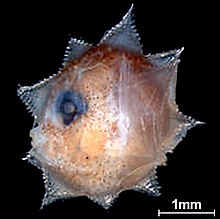

It shares many traits common to members in theorderTetraodontiformesincludingpufferfish,porcupinefish,andfilefishlike having a beak formed from four fused teeth; sunfishfryresemble spiky pufferfish more than they resemble adult molas.[18]
Thecaudal finof the ocean sunfish is replaced by a roundedclavus,creating the body's distinct truncated shape. The body is flattened laterally, giving it a long oval shape when seen head-on. The pectoral fins are small and fan-shaped, while the dorsal fin and the anal fin are lengthened, often making the fish as tall as it is long. Specimens up to 3.3 m (10 ft 10 in) in height have been recorded.[19]
The mature ocean sunfish has an average length of 1.8 m (5 ft 11 in) and a fin-to-fin length of 2.5 m (8 ft 2 in)[further explanation needed].The weight of mature specimens can range[further explanation needed]from 247 to 1,000 kg (545 to 2,205 lb),[6][20][21]but even larger individuals are not unheard of[by whom?].The maximum size recorded is 3.3 m (10 ft 10 in) in length,[19][22]and maximum weight recorded is 2,300 kg (5,100 lb).[22]
The spinal column ofM. molacontains fewervertebraeand is shorter in relation to the body than that of any other fish.[23] Although the sunfish descended frombony ancestors,its skeleton contains largelycartilaginoustissues, which are lighter thanbone,allowing it to grow to sizes impractical for other bony fishes.[23][24]Its teeth are fused into a beak-like structure,[25]which prevents them from being able to fully close their mouths, while also havingpharyngeal teethlocated in the throat.[26]
The sunfish lacks aswim bladder.[23]Some sources[who?]indicate the internal organs contain a concentratedneurotoxin,tetrodotoxin,like the organs of other poisonous tetraodontiformes,[25]while others dispute this claim.[10]
Fins
[edit]In the course of its evolution, the caudal fin (tail) of the sunfish disappeared, to be replaced by a lumpy pseudotail, the clavus. This structure is formed by the convergence of the dorsal and anal fins,[27][28]and is used by the fish as a rudder.[29]The smooth-denticled clavus retains 11-14fin raysand terminates in a number of rounded ossicles.[30]
Ocean sunfish often swim near the surface, and their protruding dorsal fins are sometimes mistaken for those ofsharks.[31]However, the two can be distinguished by the motion of the fin. Unlike most fish, the sunfish swings its dorsal fin and anal fin in a characteristicscullingmotion.[32]
Skin
[edit]Adult sunfish range from brown to silvery-grey or white, with a variety of region-specific mottled skin patterns.[6]Coloration is often darker on the dorsal surface, fading to a lighter shade ventrally as a form of countershading camouflage.M. molaalso exhibits the ability to vary skin coloration from light to dark, especially when under attack.[6]The skin, which contains large amounts of reticulated collagen, can be up to7.3 cm (2+3⁄4in) thick on the ventral surface, and is covered bydenticlesand a layer ofmucusinstead ofscales.The skin on the clavus is smoother than that on the body, where it can be as rough as sandpaper.[23]
More than 40 species ofparasitesmay reside on the skin and internally, motivating the fish to seek relief in a number of ways.[6][30][clarification needed]One of the most frequent ocean sunfish parasites is the flatwormAccacoelium contortum.[33]
In temperate regions, drifting kelp fields harborcleaner wrassesand other fish which remove parasites from the skin of visiting sunfish. In the tropics,M. molasolicits cleaning help from reef fishes. By basking on its side at the surface, the sunfish also allows seabirds to feed on parasites from its skin. Sunfish have been reported tobreach,clearing the surface by approximately 3 m (10 ft), in an apparent effort to dislodge embedded parasites.[31][34]
Range and behavior
[edit]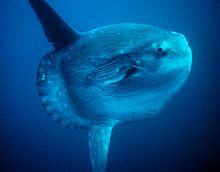
Ocean sunfish are native to thetemperateandtropicalwaters of every ocean in the world.[23]Molagenotypesappear to vary widely between theAtlanticandPacific,but genetic differences between individuals in theNorthernandSouthern hemispheresare minimal.[35]
Although early research suggested sunfish moved around mainly by drifting with ocean currents (which has resulted in the sunfish sometimes being characterized as amegaplankton[36][37]), individuals have been recorded swimming 26 km (16 mi) in a day at a cruising speed of 3.2 km/h (1.7 kn).[29]
While this might be the case most of the time, they are also capable of moving rapidly when feeding or avoiding predators, to the extent that they can vertically leap out of water. Contrary to the perception that the fish spend much of their time basking at the surface,M. molaadults actually spend a large portion of their lives actively hunting at depths greater than 200 m (660 ft), occupying both theepipelagicandmesopelagiczones.[38]

Sunfish are most often found in water warmer than 10 °C (50 °F);[38]prolonged periods spent in water at temperatures of 12 °C (54 °F) or lower can lead to disorientation and eventual death.[32]Surface basking behavior, in which a sunfish swims on its side, presenting its largest profile to the sun, may be a method of "thermally recharging" following dives into deeper, colder water in order to feed.[35][39]Sightings of the fish in colder waters outside of its usual habitat, such as those southwest of England, may be evidence of increasing marine temperatures.[40][41]
Sunfish are usually found alone, but occasionally in pairs.[23]
Feeding
[edit]The diet of the ocean sunfish was formerly thought to consist primarily of variousjellyfish.However, genetic analysis reveals that sunfish are actually generalist predators that consume mostly small fish, fish larvae,squid,andcrustaceans,with jellyfish andsalpsmaking up only around 15% of the diet.[42]Occasionally they will ingesteel grass.This range of food items indicates that the sunfish feeds at many levels, from the surface to deep water, and occasionally down to theseafloorin some areas.[6]
Life cycle
[edit]Ocean sunfish may live up to ten years in captivity, but their lifespan in a natural habitat has not yet been determined.[31]Their growth rate remains undetermined. However, a young specimen at theMonterey Bay Aquariumincreased in weight from 26 to 399 kg (57 to 880 lb) and reached a height of nearly 1.8 m (5 ft 11 in) in 15 months.[32]
The sheer size and thick skin of an adult of the species deters many smaller predators, but younger fish are vulnerable to predation bybluefin tunaandmahi mahi.Adults are consumed byorca,sharks[23]andsea lions.[6][32]
The mating practices of the ocean sunfish are poorly understood, but spawning areas have been suggested in the North Atlantic, South Atlantic, North Pacific, South Pacific, and Indian oceans.[23]
Females of the species can produce moreeggsthan any other knownvertebrate,[6]up to 300 million at a time. Sunfishfrydo not have the large pectoral fins and tail fin of their adult forms, but they have body spines uncharacteristic of adult sunfish, that disappear as they grow.
Females are estimated to be carrying as many as 300 millioneggsat one time, more than any other known vertebrate.[6][43]Sunfish eggs are released into the water andexternally fertilizedby sperm.[30]
Newly hatched sunfish larvae are only2.5 mm (3⁄32in) long and weigh less than one gram. They develop intofrythat resemble miniaturepufferfish,their close relatives.[30][44]Young sunfishschoolfor protection, but this behavior is abandoned as they grow.[45]The fry that survive can grow up to 60 million times their original weight before reaching adult proportions,[29]arguably the most extreme size growth of any vertebrate animal.[46][47]
Genome
[edit]In 2016, researchers from China National Genebank andA*STARSingapore, including Nobel laureateSydney Brenner,sequenced the genomeof the ocean sunfish and discovered several genes which might explain its fast growth rate and large body size. As member of the order Tetraodontiformes, likefugu,the sunfish has quite a compact genome, at 730 Mb in size. Analysis from this data suggests that sunfish and pufferfishes diverged approximately 68 million years ago, which corroborates the results of other recent studies based on smaller datasets.[48]
Human interaction
[edit]
Despite their size, ocean sunfish are docile and pose no threat to human divers.[30]Injuries from sunfish are rare, although a slight danger exists from large sunfish leaping out of the water onto boats. In 2005, a 1 metre (3 feet 3 inches)-long sunfish landed on a 4-year-old boy when the fish leaped onto the boy's family's boat off the coast ofPembrokeshire,Wales.[49]Areas where they are commonly found are popular destinations for sport dives, and sunfish at some locations have reportedly become familiar with divers.[25]They are more of a problem to boaters than to swimmers, as they can pose a hazard to watercraft due to their large size and weight. Collisions with sunfish are common in some parts of the world and can cause damage to the hull of a boat,[50]or to the propellers of larger ships, as well as to the fish.[30]
The flesh of the ocean sunfish is considered a delicacy in some regions, the largest markets being Taiwan and Japan. All parts of the sunfish areused in cuisine,from the fins to the internal organs.[10] Some parts are used in some areas of traditional medicine.[25]Fishery products derived from sunfish are forbidden in theEuropean Unionaccording to Regulation (EC) No 853/2004 of the European Parliament and of the Council, as they contain toxins that are harmful to human health.[12]
Sunfish are accidentally but frequently caught indrift gillnetfisheries, making up nearly 30% of the total catch of theswordfishfishery employing drift gillnets in California.[29]Thebycatchrate is even higher for the Mediterranean swordfish industry, with 71% to 90% of the total catch being sunfish.[10][45]
A decrease in sunfish populations may be caused by more frequent bycatch and the increasing popularity of sunfish in human diet.[23]The fishery bycatch and destruction of ocean sunfish are unregulated worldwide. In some areas, the fish are "finned" by fishermen who regard them as worthless bait thieves; this process, in which the fins are cut off, results in the eventual death of the fish, because it can no longer propel itself without its dorsal and anal fins.[51] The species is also threatened by floating litter such as plastic bags which resemble jellyfish, a common prey item. Bags can choke and suffocate a fish or fill its stomach to the extent that it starves.[31]
In art
[edit]Patterns of this fish, known askebuku,are seen insarongsworn by women in Lamalera, a village in the island ofLembata,in the Lesser Sunda Islands of Indonesia.[52]
In captivity
[edit]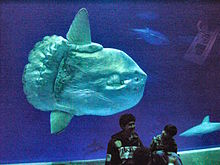
Sunfish are not widely held in aquarium exhibits, due to the unique and demanding requirements of their care. Some Asian aquaria display them, particularly in Japan.[32]TheKaiyukan AquariuminOsakais one of few aquaria withMola molaon display, where it is reportedly as popular an attraction as the largerwhale sharks.[53] TheLisbon Oceanariumin Portugal has ocean sunfish showcased in the main tank,[54]and sunfish are also on display at theDenmarkNordsøen Oceanarium.[55]
InKamogawa Sea Worldthe ocean sunfish named Kukey, who started captivity in 1982, set a world record for captivity for 2,993 days, living for eight years. Kukey was 72 cm (2.36 ft) at the time of delivery, but was 187 cm (6.14 ft) in size at the time of death.[56][57]
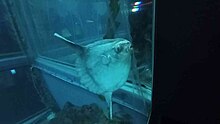
While the first ocean sunfish to be held in an aquarium in the United States is said to have arrived at theMonterey Bay Aquariumin August 1986,[58]other specimens have previously been held at other locations.Marineland of the Pacific,closed since 1987 and located on the Palos Verdes Peninsula in Los Angeles County, California, held at least one ocean sunfish by 1961,[59]and in 1964 held a 290-kilogram (650 lb) specimen, said to be the largest ever captured at that time.[60]However, another 450-kilogram (1,000 lb) specimen was brought alive to Marineland Studios Aquarium, near St. Augustine, Florida, in 1941.[61]
Because sunfish had not been kept in captivity on a large scale before, the staff at Monterey Bay was forced to innovate and create their own methods for capture, feeding, and parasite control. By 1998, these issues were overcome, and the aquarium was able to hold a specimen for more than a year, later releasing it after its weight increased by more than 14 times.[32]Mola molahas since become a permanent feature of the Open Sea exhibit.[29]Monterey Bay Aquarium's largest sunfish specimen was euthanized on February 14, 2008, after an extended period of poor health.[62]
A major concern to curators is preventive measures taken to keep specimens in captivity from injuring themselves by rubbing against the walls of a tank, since ocean sunfish cannot easily maneuver their bodies.[53]In a smaller tank, hanging a vinyl curtain has been used as a stopgap measure to convert a cuboid tank to a rounded shape and prevent the fish from scraping against the sides. A more effective solution is simply to provide enough room for the sunfish to swim in wide circles.[32]The tank must also be sufficiently deep to accommodate the vertical height of the sunfish, which may reach 3.2 m (10 ft 6 in).[19]
Feeding captive sunfish in a tank with faster-moving, more aggressive fish can also present a challenge. Eventually, the fish can be taught to respond to a floating target to be fed,[63][better source needed]and to take food from the end of a pole or from human hands.[32]
References
[edit]- ^abPorcasi, Judith F.; Andrews, Sherri L. (7 July 2001)."Evidence for a PrehistoricMola molaFishery on the Southern California Coast "(PDF).Journal of California and Great Basin Anthropology.23(1): 51–66.JSTOR27825752.Archived fromthe original(PDF)on 17 April 2024.Retrieved20 May2024.
- ^Liu, J.; Zapfe, G.; Shao, K.-T.; Leis, J.L.; Matsuura, K.; Hardy, G.; Liu, M.; Robertson, R.; Tyler, J. (2016) [errata version of 2015 assessment]."Mola mola".IUCN Red List of Threatened Species.2015:e.T190422A97667070.Retrieved11 July2024.
- ^"IUCN Red List of threatened species includes ocean sunfish".The Japan Times.Japan. The Japan Times, Ltd. ( kabushiki gaisha ジャパンタイムズ). 19 November 2015.Archivedfrom the original on 20 May 2024.Retrieved20 May2024.
- ^"Mola mola".NatureServeExplorer.Retrieved17 April2024.
- ^van der Land, Jacob (7 December 2021) [21 December 2004]. Bailly, Nicolas (ed.)."Mola mola(Linnaeus, 1758) ".WoRMS.World Register of Marine Species.Retrieved24 May2024.
- ^abcdefghijThys, Tierney."Molidae Descriptions and Life History".OceanSunfish.org.Retrieved2007-05-08.
- ^Froese, Rainer;Pauly, Daniel (eds.)."Family Molidae".FishBase.March 2013 version.
- ^Sawai, Etsuro; Yamanoue, Yusuke; Nyegaard, Marianne & Sakai, Yoichi (5 December 2017) [22 July 2017]. "Redescription of the bump-head sunfishMola alexandrini(Ranzani 1839), senior synonym ofMola ramsayi(Giglioli 1883), with designation of a neotype forMola mola(Linnaeus 1758) (Tetraodontiformes: Molidae) ".Ichthyological Research.65.Springer Science+Business Media:142–160.doi:10.1007/s10228-017-0603-6.
- ^ab"Current Research".Large Pelagics Research Lab. Archived fromthe originalon 2011-07-20.
- ^abcdeThys, Tierney."Ongoing Research".OceanSunfish.org.Retrieved2007-06-11.
- ^"Have you seen aMola?? ".Large Pelagics Research Lab. Archived fromthe originalon 2011-09-01.
- ^ab"Regulation (EC) No 853/2004 of the European Parliament and of the Council of 29 April 2004 laying down specific hygiene rules for food of animal origin".Eur-lex.europa.eu.Retrieved2010-11-16.
- ^Parenti, Paolo (September 2003)."Family Molidae Bonaparte 1832: molas or ocean sunfish"(PDF).Annotated Checklist of Fishes (Electronic Journal).18.ISSN1545-150X.Archived fromthe original(PDF)on 4 October 2013.Retrieved6 February2012.
- ^Lewis, Charlton T.; Short, Charles (1879)."mola".A Latin Dictionary.Perseus Digital Library.
- ^abScharpf, Christopher; Lazara, Kenneth J. (12 June 2023)."Family TETRADONTIFORMES"(PDF).The ETYFish Project.Retrieved25 October2023.
- ^Bass, L. Anna; Dewar, Heidi;Thys, Tierney;Streelman, J. Todd.; Karl, Stephen A. (July 2005)."Evolutionary divergence among lineages of the ocean sunfish family, Molidae (Tetraodontiformes)"(PDF).Marine Biology.148(2).Springer Science+Business Media:405–414.Bibcode:2005MarBi.148..405B.doi:10.1007/s00227-005-0089-z.S2CID30632282.Archived(PDF)from the original on 29 October 2023.Retrieved24 May2024.
- ^"Evolution".Retrieved10 June2024.
- ^Thys, Tierney (2002)."Molidae information and research (Evolution)".OceanSunfish.org.Retrieved26 June2007.
- ^abcJuliet Rowan (November 24, 2006)."Tropical sunfish visitor as big as a car".The New Zealand Herald.Retrieved9 May2023.
- ^Watanabe, Yuuki; Sato, Katsufumi (2008-10-22)."Functional Dorsoventral Symmetry in Relation to Lift-Based Swimming in the Ocean SunfishMola mola".PLOS ONE.3(10): e3446.Bibcode:2008PLoSO...3.3446W.doi:10.1371/journal.pone.0003446.PMC2562982.PMID18941510.
- ^Nakatsubo, Toshiyuki; Kawachi, Masahiro; Mano, Nobuhiro; Hirose, Hitomi (2007), "Estimation of Maturation in Wild and Captive Ocean SunfishMola mola",Thủy sản tăng thực(in Japanese),55(2): 259–264,doi:10.11233/aquaculturesci1953.55.259,ISSN0371-4217
- ^abMcClain, Craig R.; Balk, Meghan A.; Benfield, Mark C.; Branch, Trevor A.; Chen, Catherine; Cosgrove, James; Dove, Alistair D.M.; Gaskins, Lindsay C.; Helm, Rebecca R. (2015-01-13)."Sizing ocean giants: patterns of intraspecific size variation in marine megafauna".PeerJ.3:e715.doi:10.7717/peerj.715.ISSN2167-8359.PMC4304853.PMID25649000.
- ^abcdefghi"Mola mola program - Life History".Large Pelagics Research Lab. Archived fromthe originalon 2011-08-19.
- ^Adam Summers."No Bones About 'Em".Natural History Magazine. Archived fromthe originalon September 27, 2007.Retrieved2007-06-30.
- ^abcdGomes-Pereira, José Nuno; Pham, Christopher K.; Miodonski, Joana; Santos, Marco A. R.; Dionísio, Gisela; Catarino, Diana; Nyegaard, Marianne; Sawai, Etsuro; Carreira, Gilberto P.; Afonso, Pedro (October 11, 2022)."The heaviest bony fish in the world: a 2744 kg giant sunfish Mola alexandrini (Ranzani, 1839) from the North Atlantic".Journal of Fish Biology.102(1): 290–293.doi:10.1111/jfb.15244.PMID36218082.S2CID252816489.
- ^Bone, Quentin; Moore, Richard (2008).Biology of Fishes.Taylor & Francis US. p.210.ISBN978-0203885222.
- ^"Strange tail of the sunfish".The Natural History Museum.Retrieved2007-05-11.[dead link]
- ^Johnson, G. David; Britz, Ralf (October 2005). "Leis' Conundrum: Homology of the Clavus of the Ocean Sunfishes. 2. Ontogeny of the Median Fins and Axial Skeleton ofRanzania laevis(Teleostei, Tetraodontiformes, Molidae) ".Journal of Morphology.266(1): 11–21.doi:10.1002/jmor.10242.PMID15549687.S2CID43363353.
We thus conclude that the molid clavus is unequivocally formed by modified elements of the dorsal and anal fin and that the caudal fin is lost in molids.
- ^abcde"Meet the ocean sunfish (Mola mola)".Monterey Bay Aquarium.Animals A to Z.Archivedfrom the original on 5 September 2024.Retrieved5 September2024.
- ^abcdefParkinson, Kerryn (12 August 2023) [6 April 2011]."Ocean Sunfish,Mola mola(Linnaeus, 1758) ".Australian Museum.Archivedfrom the original on 5 September 2024.Retrieved5 September2024.
- ^abcd"Mola (Sunfish)".National Geographic. Archived fromthe originalon November 14, 2006.Retrieved2007-05-08.
- ^abcdefghPowell, David C. (2001)."21. Pelagic Fishes".A Fascination for Fish: Adventures of an Underwater Pioneer.Berkeley: University of California Press, Monterey Bay Aquarium. pp.270–275.ISBN978-0-520-22366-0.OCLC44425533.Retrieved2007-06-13.
- ^Ahuir-Baraja, Ana Elena; Padrós, Francesc; Palacios-Abella, Jose Francisco; Raga, Juan Antonio; Montero, Francisco Esteban (15 October 2015)."Accacoelium contortum (Trematoda: Accacoeliidae) a trematode living as a monogenean: morphological and pathological implications".Parasites & Vectors.8:540.doi:10.1186/s13071-015-1162-1.ISSN1756-3305.PMC4608113.PMID26471059.
- ^Thys, Tierney (2007)."Help Unravel the Mystery of the Ocean Sunfish".OceanSunfish.org.Retrieved2013-05-17.
- ^ab Thys, Tierney (30 November 2003)."Tracking Ocean Sunfish,Mola molawith Pop-Up Satellite Archival Tags in California Waters ".OceanSunfish.org.Retrieved2007-06-14.
- ^Coulombe, Deborah A. (1992).The Seaside Naturalist: A Guide to Study at the Seashore.Fireside Books.p. 236.ISBN0-671-76503-5.
- ^Ireland, Tom."Book Reviews | Planktonia: The nightly migration of the ocean's smallest creatures".The Biologist.Royal Society of Biology.RetrievedJanuary 15,2024.
- ^ab"Mola mola program - Preliminary results".Large Pelagics Research Lab. January 2006. Archived fromthe originalon 2011-07-20.
- ^ "The Biogeography of Ocean Sunfish (Mola mola)".San Francisco State University Department of Geography. Fall 2000.Retrieved2008-04-25.
- ^Oliver, Mark & agencies (25 July 2006)."Warm Cornish waters attract new marine life".Guardian.co.uk.Retrieved2007-05-08.
- ^"Giant sunfish washed up on Overstrand beach in Norfolk".BBC News Online.BBC.10 December 2012.Archivedfrom the original on 6 September 2023.Retrieved22 May2024.
- ^Sousa, Lara L.; Xavier, Raquel; Costa, Vânia; Humphries, Nicolas E.; Trueman, Clive; Rosa, Rui; Sims, David & Queiroz, Nuno (4 July 2016)."DNA barcoding identifies a cosmopolitan diet in the ocean sunfish"(PDF).Scientific Reports.6(1). Nature Portfolio: 28762.Bibcode:2016NatSR...628762S.doi:10.1038/srep28762.PMC4931451.PMID27373803.Archived(PDF)from the original on 5 November 2023.Retrieved22 May2024.
- ^Freedman, Jonathan A.; Noakes, David L.G. (2002). "Why are there no really big bony fishes? A point-of-view on maximum body size in teleosts and elasmobranchs".Reviews in Fish Biology and Fisheries.12(4): 403–416.doi:10.1023/a:1025365210414.S2CID36649270.
- ^Fishes of the Gulf of Maine."The Ocean Sunfishes or Headfishes".Fishes of the Gulf of Maine.Retrieved2007-06-30.
- ^abTierney Thys(February 2003).Swim with giant sunfish in the open ocean(Professional conference). Monterey, California, United States: Technology Entertainment Design.Retrieved2007-05-30.
- ^Wood, The Guinness Book of Animal Facts and Feats. Sterling Pub Co Inc. (1983),ISBN978-0-85112-235-9
- ^Kooijman, S. A. L. M., & Lika, K. (2013). Resource allocation to reproduction in animals.Am. Nat.subm, 2(06).
- ^Pan H, Yu H, Ravi V, et al. (9 September 2016)."The genome of the largest bony fish, ocean sunfish (Mola mola), provides insights into its fast growth rate ".GigaScience.5(1): 36.doi:10.1186/s13742-016-0144-3.PMC5016917.PMID27609345.
- ^"Boy struck by giant tropical fish".BBC.28 August 2005.Archivedfrom the original on 20 February 2024.Retrieved24 May2024.
- ^Lulham, Amanda (23 December 2006)."Giant sunfish alarm crews".The Daily Telegraph.Archived fromthe originalon 4 March 2009.Retrieved12 June2007.
- ^Thys, Tierney."Present Fishery/Conservation".Large Pelagics Lab. Archived fromthe originalon 2011-07-20.
- ^Barnes, Ruth (1988). "Ikat Patterns Found in Lamalera".Ikat Textiles of Lamalera: A Study of an Eastern Indonesian Weaving Tradition.Studies in South Asian Culture. Vol. 14. Leiden, Netherlands:Brill Publishers.pp. 60–63.ISBN90-04-08753-2.ISSN0169-9865.LCCN88024088.OCLC18324163.
- ^ab"Main Creature in Kaiyukan".Osaka Kaiyukan Aquarium. Archived fromthe originalon May 28, 2007.Retrieved2007-06-13.
- ^"Ocean Sunfish".Oceanário de Lisboa.Lisbon.7 March 2019.Archivedfrom the original on 22 May 2024.Retrieved22 May2024.
- ^Nordsøen Oceanarium:The Open Sea.Archived2015-07-05 at theWayback MachineRetrieved 8 December 2012.
- ^"さかまた no92"(PDF).Vịt xuyên シーワールド.[permanent dead link]
- ^"Nhật Bản でマンボウに sẽ える thủy tộc quán は? マンボウはフグ の trọng gian!? ヒレや vịnh ぎ phương に chú mục!".るるぶKids.4 December 2020.
- ^"Aquarium Timeline".Monterey Bay Aquarium. Archived fromthe originalon 2008-05-11.Retrieved2007-06-11.
- ^Caldwell, David K.; Brown, David H. (January–March 1964)."Notes on killer whales".Bulletin of the Southern California Academy of Sciences.63(3). Los Angeles, California: Southern California Academy of Sciences: 137.
- ^Los Angeles Times.June 15, 1964.p. 3
- ^The Miami News, March 16, 1941, p. 5-C
- ^"Aquarium Euthanizes Its Largest Ocean Sunfish".KSBW. 14 February 2008. Archived fromthe originalon 2011-07-13.Retrieved2008-12-20.
- ^Life in the slow lane.Monterey Bay Aquarium. Archived fromthe originalon 17 October 2012.Retrieved24 October2010.
External links
[edit]Research and info
[edit]Images and videos
[edit]- Mike Johnson Natural History Photography
- Phillip Colla Photography/Oceanlight
- Video lecture (16:53):Swim with giant sunfish in the open ocean-Tierney Thys
- SkaphandrusMola mola photosArchived2016-01-05 at theWayback Machine
- Photos ofOcean sunfishon Sealife Collection


